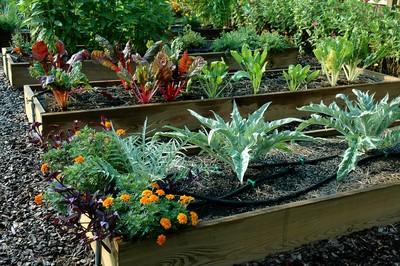Thinking outside the box
I'm often asked about gardening in raised beds. Here's my answer: It's one of the best ways to grow productive and healthy plants and, given the option, I'd choose raised beds every time.
I attribute much of the success experienced on the set of my TV program "Fresh From the Garden" to growing just about everything in raised beds. They allow for better control of drainage, the opportunity to create custom soil, a defined planting area and a more user-friendly work area, just to name a few of the benefits.
Although raised beds can be as simple as mounding up soil into a deep, wide planting area, I'll address those with physical borders for this discussion. Here are some things to consider when building your own:
Materials
Anything to retain the soil works, from scrap concrete to lumber to railroad ties, etc. Even composite wood, made of recycled plastic and wood fiber, is becoming more popular.
I prefer a nontreated, rot-resistant lumber such as cedar. Pressure-treated wood is less expensive and readily available, but there is some debate around the safety of its use, especially if using these beds for edibles.
Height
I have had excellent success with beds that are 12 inches tall. This gives plant roots a great environment for expansion and growth. However, a 6-inch bed height is adequate if your soil is well amended. Some raised beds are even a back-saving waist high to minimize bending over. As long as the soil is well amended, anything over 6 inches is a bonus.
Length and width
Length is completely optional and limited primarily to your physical space. Width, on the other hand, is more important. Beds should be wide enough to allow for at least two rows of plants. Three rows are desirable in many cases. However, don't make the bed so wide that you can't reach into the center.
All the beds on the "Fresh From the Garden" set were 12 feet long and 3 feet wide. The plants grew well, and I was always able to plant at least two rows across.
However, I think a bed that is 4-feet wide is ideal and provides even more planting options.
Other considerations
When using flexible material such as lumber, the pressure of the soil will cause the wood to bow out. You should provide staking half-way down the length and secure the wood to it to prevent this outward bowing.
If using wood, build the frame so that the wood grain on all boards is facing inward. Otherwise, they may pull away and curve toward the outside as the wood dries and weathers. Not only is this unsightly, it can pull the screws or nails out as well, making your beds less secure.
Speaking of screws, I prefer them instead of nails for securing the wood. Screws are forgiving if you make a mistake. But be sure to use all-weather wood screws with a length of at least 3 inches. To prevent splitting, it is a good idea to drill pilot holes first; especially towards the ends of each piece.
Premade kits are now readily available that include connecting joints and hinges, so you can configure your bed shape and height just about any way you'd like. These devices make bed setup a snap and no construction is required. When it comes to simplicity for raised-bed construction, these kits are ideal. You can find them through many catalog and mail-order garden supply companies.
If you really want to have a beautiful and productive garden, give raised beds a try. They've never been easier to make and the advantages for you and your plants are numerous. Even better, they'll be there waiting on you season after season. What could be easier?
Joe Lamp'l, host of "Fresh From the Garden" on the DIY Network and "GardenSMART" on PBS, is a master gardener and author. For more information, visit www.joegardener.com.)






















